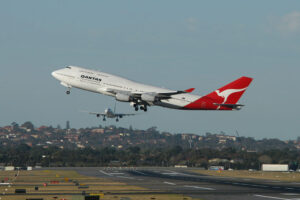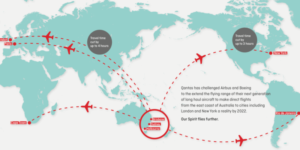 According to a report by Aaron Hilsz-Lothian of Sam Chui’s weekly aviation newsletter, Qantas CEO Alan Joyce has reaffirmed his airlines’ commitment to ultra-long-haul travel, stating an order for the Airbus A350-1000 could be made at the end of 2021 to launch flights in 2024.
According to a report by Aaron Hilsz-Lothian of Sam Chui’s weekly aviation newsletter, Qantas CEO Alan Joyce has reaffirmed his airlines’ commitment to ultra-long-haul travel, stating an order for the Airbus A350-1000 could be made at the end of 2021 to launch flights in 2024.
In an interview on an Aviation Straight Talk event, Joyce provided details on Qantas’ position throughout COVID-19 aviation crisis, including its commitment to Project Sunrise and restarting international travel with Project Sunrise Qantas’ efforts of bringing non-stop flights up to 21 hours in length to reality.
It is reported that the flights would focus on connecting the east coast of Australia to parts of Europe and America and the name reflects the sheer distance of the flights, which allow passengers and crew to witness two sunrises.
After opting for an adapted version of the Airbus A350-1000 over the Boeing 777X, Qantas was weeks away from placing an order before COVID-19 put the plans on hold in May 2020.
Now, with vaccines for the virus are distributed around the world, Joyce sees the non-stop flights the way of the future. With QANTAS having previously stated vaccines will play a major part in resuming travel, with strong support for the “no jab, no-fly” condition.
A firm backing for ultra-long lights already exists within the QANTAS network, with their non-stop Perth to London flight was their most profitable international route before COVID-19, and it held the most passenger satisfaction, with Joyce placing extra confidence in Project Sunrise by stating passengers would rather spend 18-20 hours in a clean and controlled environment than add a stop halfway along their journey.
Joyce confirmed the cabin for the globe-trotting A350-1000s has already been finalised and will be far greater than anything they have put in the air before, with Australian Executive Traveller providing insight to this via a previous interview, disclosing there will be six first-class seats in a 1-1-1 configuration, with an adequately sized business, premium and economy section.
Areas to maintain passenger and crew mental and physical wellbeing are also included in the cabin design thanks to research conducted by Sydney University’s Charles Perkins Centre and Monash University, in conjunction with CRC for Alertness, Safety and Productivity.
In addition to physical cabin features, a menu that optimises bodily functions for rest, relaxation and alertness will also be incorporated.
More can be seen on what is involved in Project Sunrise by viewing Sam Chui’s experience on a research flight:
As for COVID-19, the report says that nothing has been disclosed about what changes will be made to aircraft cabins to help passengers regain their confidence in international flight. Rather, airlines and manufacturers have been busy highlighting existing technologies in aircraft such as high-efficiency particulate air filters (HEPA) for cabin air circulation and ultra-violet lights in combination with anti-bacterial surfaces to curb the spread of COVID and other infectious substances.
As mentioned, just before Sunrise was put on hold, Qantas had selected the A350 over the 777X but had not placed an order, with instead, the airline was working with Airbus on contractual terms to initially take up to 12 aircraft.
Details on the aircraft remain limited, however, at the time of the announcement QANTAS said Airbus will add an additional fuel tank and slightly increase the maximum take-off weight to deliver the performance required for the long-range flights.
It is unknown how much modification Airbus will need to undertake to bring the aircraft to QANTAS spec, or if there will be other demand for an extended range -1000 model, however, QANTAS has succeeded in scoring specialised aircraft in the past.
The Boeing 747-400ER was a QANTAS exclusive variant of the 747-400. Having only ordered six, the modifications performed on the aircraft were similar to what’s planned for the A350-1000s they are set to take.
on the aircraft were similar to what’s planned for the A350-1000s they are set to take.
QANTAS highlighted the excellent service record of the A350 and its Rolls-Royce Trent XWB engine when announcing their decision; and when it comes to ultra-long-haul flights reliability, safety and performance is extremely important.
Joyce said, “The A350 is a fantastic aircraft and the deal on the table with Airbus gives us the best possible combination of commercial terms, fuel efficiency, operating cost and customer experience.”
In addition to operating the A350-1000 and Boeing 787 Dreamliner on international flights, Qantas still sees an important spot for the A380 on heavy trunk routes, with Joyce saying
Los Angeles is a perfect business case for the A380 purely because of the scheduling windows QANTAS has to meet to comply with curfews., adding, “Rather than flying multiple frequencies right on top of each other, an A380 that’s fully or nearly fully written down, if it generates cash, will absolutely work.”
He added that similar scheduling windows and seriously expensive slots at Heathrow Airport also make the A380 shine, however as the airline begins to take A350-1000s for Project Sunrise, the use case for the A380 is expected to decline, but the report says that after spending millions of dollars on new interiors that saw the light of day for such a short time, the A380 isn’t expected to leave anytime in the near future, and the aircraft still remains to be a highly popular choice for international travellers.
An edited report from Sam Chui’s weekly aviation newsletter by John Alwyn-Jones


















